In May, 2013, we went canoeing &
camping to Algonquin Park, hoping to relax, enjoy Ontario’s wilderness and
serenity and especially take hundreds of photographs of ubiquitous moose
wandering all over the park at that time. Well, we did not take one thing into
account: black flies! There were huge swarms of those tiny insects which, along
with mosquitoes, were incessantly attacking us. We were forced to cut our trip
short and left the park after just two nights. Not wanting to have a similar
experience, we decided to go south this time, to Port Burwell Provincial Park,
where black flies are non-existent. Although the area is totally different from
the northern shield country, we were looking forward to visiting this park.
We left Toronto on May 19, 2014, on
Victoria Day—the first long weekend of the season. After driving for an hour or
so on Highway 401, we eventually took country roads and soon arrived at the
town of Delhi (pronounced ‘dell high’), pulled into a pleasant town park next
to the Tobacco Museum and parked across a small waterfall. Delhi has been known
as the Heart of the Tobacco Country—it was here that basically 100% of Canadian
tobacco is grown. Yet its production has declined over the past decades due to
the dwindling of the number of smokers, thus leading to the weakening of the
tobacco industry. Although there are still plenty of tobacco fields, we also
saw a new, exotic crop—ginseng; it takes several years for it to mature and be
harvested, but there is a great demand, especially from the Chinese community
and its prices are very high.
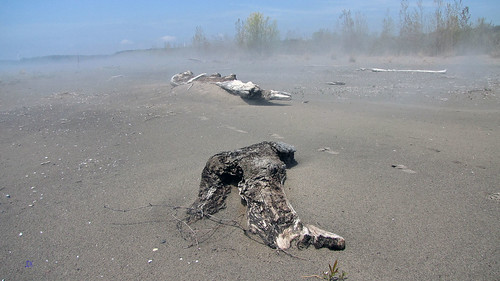 |
| Lake Erie Beach at the park-misty and mysterious... |
A lot of immigrants from different
countries have settled in Delhi and thus it is a very multicultural city. We
saw a Polish, German, Belgian and Hungarian halls/community centers; we were
told there used to be a Portuguese and Italian center as well. When we stopped
at a garage sale (Catherine’s de rigeur
stops), the vendors were of Dutch origin. We noticed a black flag in front of
the Polish Hall; later I found out it was due to the death of Bazyli Piekarski,
who used to be the manager of the Polish Hall.
Our next stop was the town of
Vienna. When Catherine had been doing her research, somehow she got the
impression that the town resembled the capital of Austria (she was told this in
a phone conversation by a park office employee). I did not want to put her
right and instead told her that indeed, there was an impressive Opera building
and even Bizet’s “Carmen” was on. Catherine got quite excited about attending
this performance.
“Why did not you tell me that in Toronto?” she asked, “I’d have brought
more formal clothes.”
Once we got to Vienna, I had a great
laugh! It was a very small, farming community, with just a few dozen stores.
Pointing to a bigger, barn-like dilapidated building, I asked her,
“Perhaps this is the opera house?”
Yet there was another thing that
might have put this town on the map: the Edison family once had lived there.
Thomas Alva Edison’s father, Samuel Edison, had to escape to the United States
after the Mackenzie Rebellion of 1837; otherwise Thomas Alva Edison might have
been born in Canada! The young Thomas Edison spent many summers in Vienna with
his grandfather. Interestingly, the original Edison homestead was moved to the
USA by Henry Ford in the 1930s!
We also dropped in on a grocery
store located at in intersection of two country roads. The store was doing a
brisk business and it was also selling Mexican food and fabrics, mainly to the
Mennonites living in the area. We were fairly surprised to see that they were
using credit cards and driving all-wheel vehicles, not horse-drawn wagons!

We also stopped at a unique cemetery
for pets only (Sandy Ridge Pet Cemetery, south of Tillsonburg). There were
plenty of nice headstones and tributes to the Rovers and Fidos of the world and
a few fitting remembrances to the feline crowd. There were even inscriptions in
Polish, Jewish, Russian, Chinese and other languages. While reading those
poignant words, you could immediately feel that they were so genuine, flowing
from the heart.
Upon arriving at Port Burwell Provincial
Park, we went to the empty registration office. According to the posted
information, we were supposed to pick a campsite and self-register. The park
was virtually empty and we drove to campsite #118, covered with trillium
flowers, but it backed on a factory nearby. So, we continued to search for the
perfect non-reserveable site and finally found a very good site no. 36.
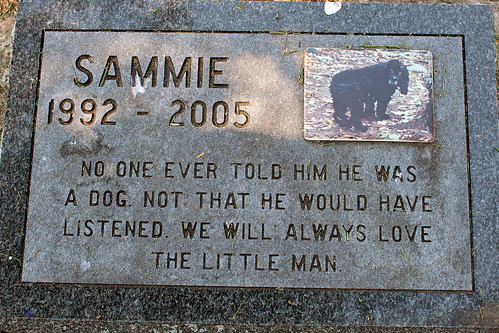
As I said before, the park was
almost deserted (5 sites taken out of 356) and even though there were plenty of
campsites around, we had been enjoying total privacy… until three college-age
girls arrived and set up their tent at the adjacent campsite and proceeded to play nonstop talk radio on site even when
they were off site! Honestly, sometimes I do not understand people…
The town of Port Burwell had a very
distinct lighthouse (one of Canada’s oldest), Trinity Anglican Church and a
cemetery where many descendants of the town’s founder, Mahlon Burwell, were
buried. While camping in Port Burwell in 2006, I had seen an announcement at the
local library about Fred Bodsworth, a well-known author, journalist and
naturalist who was born in Port Burwell in 1918 and who was going to visit his
birthplace and sign his books. Although I was not going to be in Port Burwell
at that time, I managed to buy one of his most famous books, “The Last of the
Curlews” (with his autograph!). Fred Bodsworth passed away in 2012 and we
visited his grave at the cemetery.
The Trinity Anglican Church was the
gift of Colonel Mahlon Burwell. After John Strachan’s inaugural service at
Trinity on May 22nd, 1836, the church was officially opened.
Unfortunately, it was closed and we were unable see its interior.
In the nineteenth century Port
Burwell was well-known for its shipbuilding; in additions, a number of fisheries
operated from Port Burwell, albeit their success fluctuated, depending upon the
fish stocks, which eventually declined and in 2014 only one fishing tug
operated from Port Burwell—it was still possible to buy fresh fish directly
from fishermen.
However, one of the most memorable
industries in Port Burwell was coal shipping. From 1906 to 1950 a car ferry
called The Ashtabula (the name is derived from ashtepihəle, which means
'always enough fish to be shared around' in the Lenape language), with built in
track to transport railcars across the lake, made round trips from Ashtabula,
Ohio to Port Burwell, shipping coal across Lake Erie to Canada and carrying
newsprint and limestone from Canada to the United States. The coal was then
transported by rail to such areas as Tillsonburg and Woodstock and often used
in kilns to dry tobacco leaves. By 1955, the Ashtabula made 12,000 round trips,
up to 250 trips per year in the postwar period. Eventually coal shipping
stopped when diesel engines became popular. On September 18, 1958, the
Ashtabula collided with the Ben Moreell, a bulk freighter, near its port in
Ohio. Although there was no loss of live, her damage was so extensive that she
was scrapped. At the time of the collision she was captained by Louis Sabo, who
had spent 31 years, half of his life, on the Ashtabula. The preliminary inquiry
by the Coast Guard accused Sabo of various infractions that led to the
accident. The night before the full inquiry for disciplinary action was to be
held, Capitan Sabo went to his garage, turned on his car and was found on the
floor in the morning, asphyxiated. In addition, an insurance inspector, while
examining the Ashtabula, fell through a hole to his death. Thus, two deaths
were indirectly caused by the accident.
Today it is still possible to see
rotted ties at the mouth of the Big Otter Creek, where the railway terminal
used to be located. The rail tracks had been lifted long ago and a narrow path
marks the old train route. About ten years ago I went to Port Stanley; there
was a train operated by volunteers that took tourists to St. Thomas and back.
One of the train’s engineers told me that he had driven the last train from
Port Burwell.
We also went to the beach (on Lake
Erie). Since it had rained previously, thick mist was enveloping the dunes and
driftwood — the whole area resembled a scene from a horror movie! Catherine
decided to go for a walk and soon vanished in the dense mist, only to re-appear
after thirty minutes.
 |
| In front of a Mennonite store in Aylmer |
The next day it was raining and we
drove to the town of Aylmer, where we spent a few hours at a farmers’ market
a.k.a. flea market, where we bought some vegetables and sausage. Quite a few of
the vendors were Mennonites. Then we drove to a nearby Ontario Police College;
every police officer in Ontario must spent 13 weeks training there. We received
visitors’ passes and wandered around the building. There was a small police
museum and a memorial dedicated to policemen killed in the line of duty—some of
them I remembered as their shootings were on the cover pages of newspapers for
many days. We also saw a lot of students—all were uniformed and even carried
guns, albeit not real (as I suspected—I would not like to be a teacher arguing
with armed students over their grades!). Outside there was a fake mall, firing
range and driving training facilities. The college was erected on the grounds
of the former Royal Canadian Air Force Station, constructed during the Second
World War.
 |
| Torpedo room |
Yet the absolute highlight of this
trip was a new attraction that awaited us in Port Burwell—namely, a real
submarine! It was the HMSC Ojibwa, an Oberon-class submarine that served in the
Royal Canadian Navy, mainly spying on the Warsaw Pact navy. After being
decommissioned, in 2012 it arrived in Port Burwell and is open for visitors.
 |
| The Submarine in Port Burwell |
We started in the forward torpedo
room and our very knowledgeable guides told us a lot of fascinating details
about torpedoes and the firing procedures. It was only possible to take
photographs in that room. Then we proceeded to the Control Room, Engine Room,
Motor Room and the Stern Torpedo Room. It was an absolutely captivating
tour—finally I was able to personally see what I had only watched on TV! It was
unbelievable how little privacy the crew had. There were six-foot bunks and
there were more people on-board than regular bunks —after all, there was never
time when everyone was asleep, so you slipped into any bunk that was
unoccupied. Only the captain had a private stateroom—if you can call that a
room, as it resembled a tiny cubbyhole-I am sure that inmates in Canadian
penitentiary institutions enjoy bigger cells! The washrooms cubicles were so
small that it was impossible to fit in without leaving the door open. Even
though the submarine was decommissioned in 1998, the whole interior was
permeated with the smell of diesel (which made Catherine feel nauseous). And
then there was the motor room—according to the tour guide, the noise there was
comparable to that of a jet taking off; those working there invariably suffered
serious hearing loss. I could go on and on… the whole tour lasted just over 1
hour and cost just under $20, but other, more comprehensive tours are offered,
which I would love to take in the future. In any case, I do not think I would
be able to serve on a submarine, especially living there for months… I still
prefer my canoe!
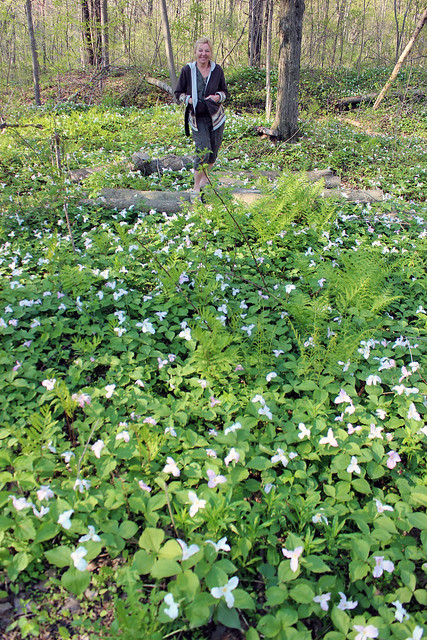 |
| At Port Burwell Provincial Park--among Trillium grandiflorum, the official flower of the Province of Ontario |
We also drove along the shores of
Lake Erie and arrived at Long Point—a very long peninsula, which is famous for
bird migration and habitat—and checked out Long Point Provincial park. The open
area, used mainly by RVs, was not very impressive, yet Catherine absolutely
fell in love with much more cozy campsites close to the lake—they were sandy
and much more secluded. Well, I know where we are going camping next May! Later
we went to Turkey Point Provincial Park, with a long beach, albeit totally
empty.
Overall, it was a very nice camping
trip which allowed us to discover a new part of Ontario—and explore a real
submarine! Although we still prefer the rugged Canadian Shield, we will
certainly visit the shores of Lake Erie in the following years, especially in
May or June.
Blog
po polsku/in the Polish language: http://ontario-nature-polish.blogspot.ca/2015/10/port-burwell-ontario-maj-2014-r.html
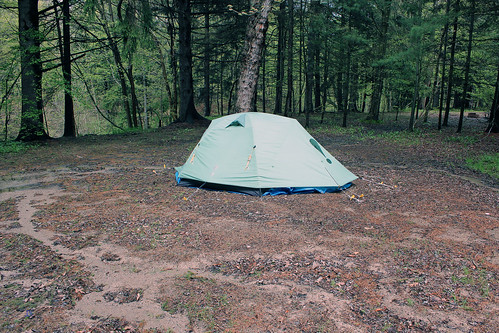
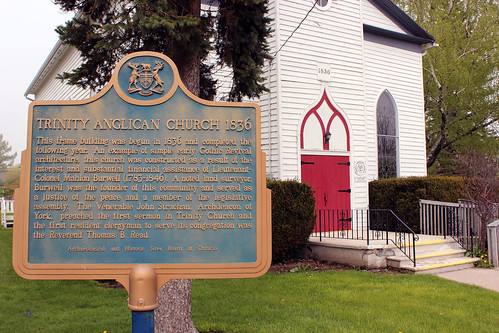
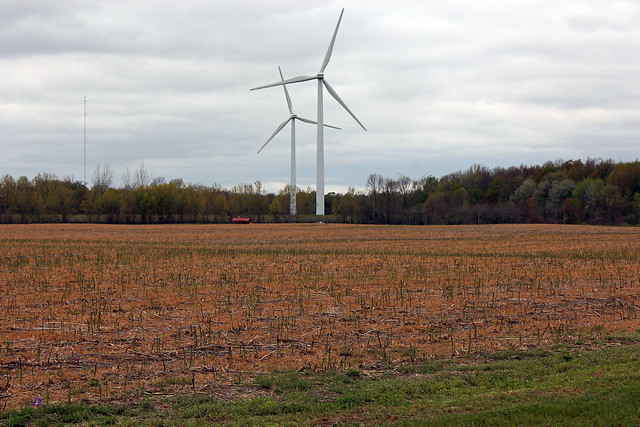
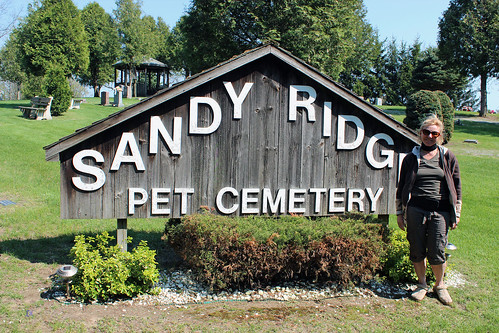
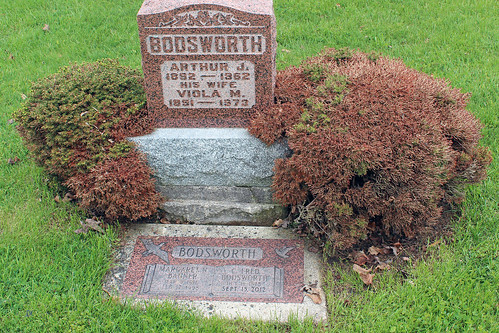
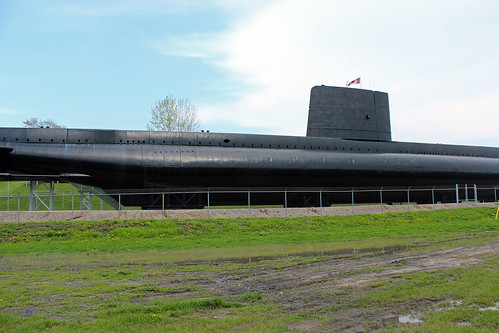
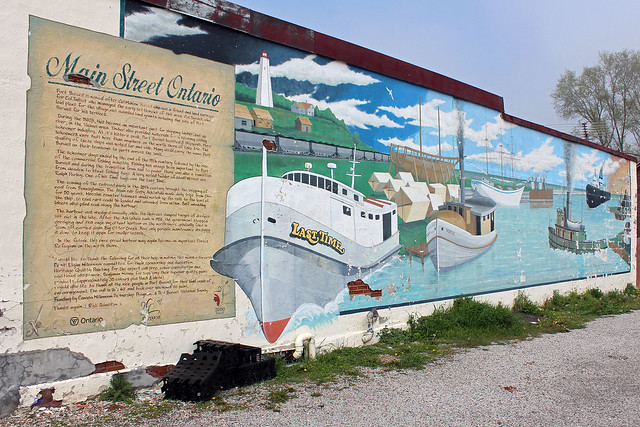
No comments:
Post a Comment